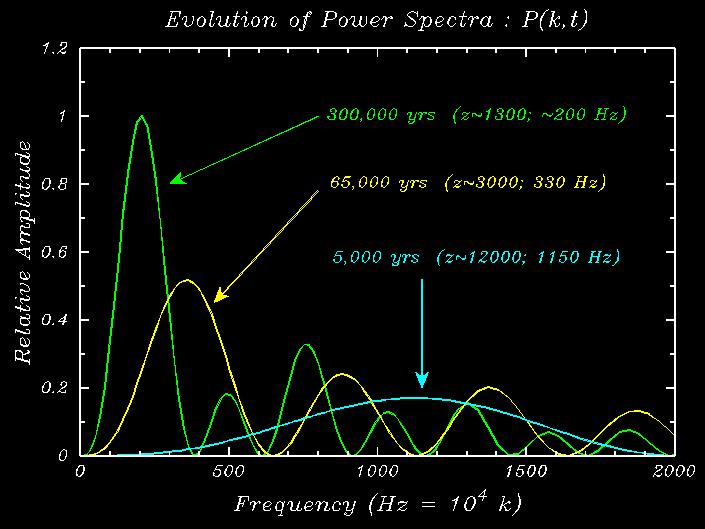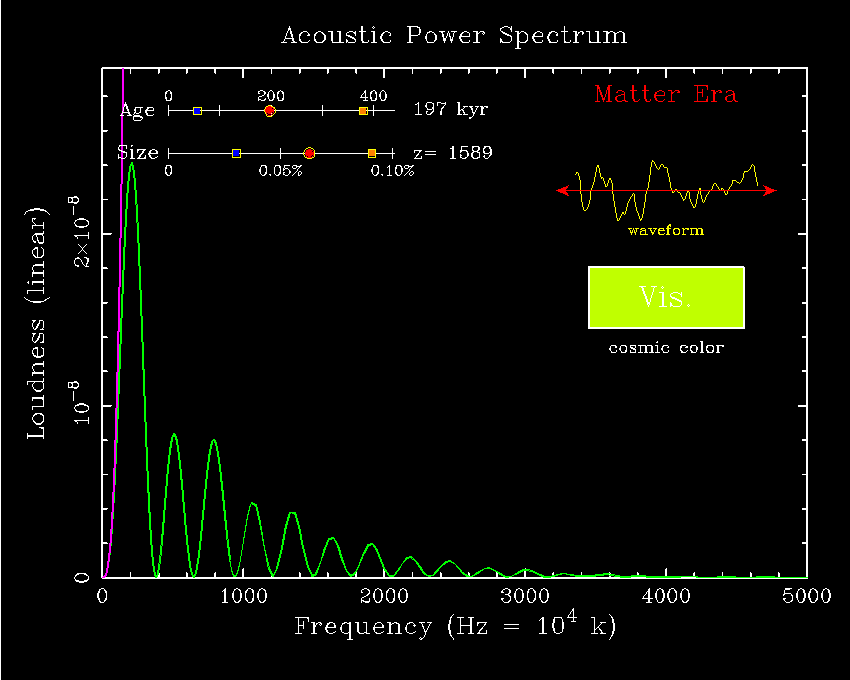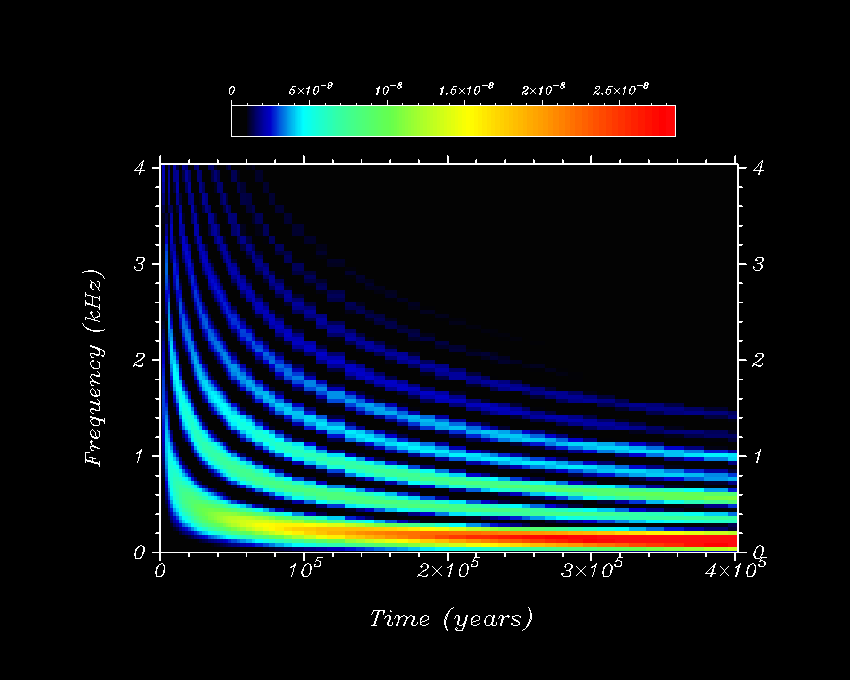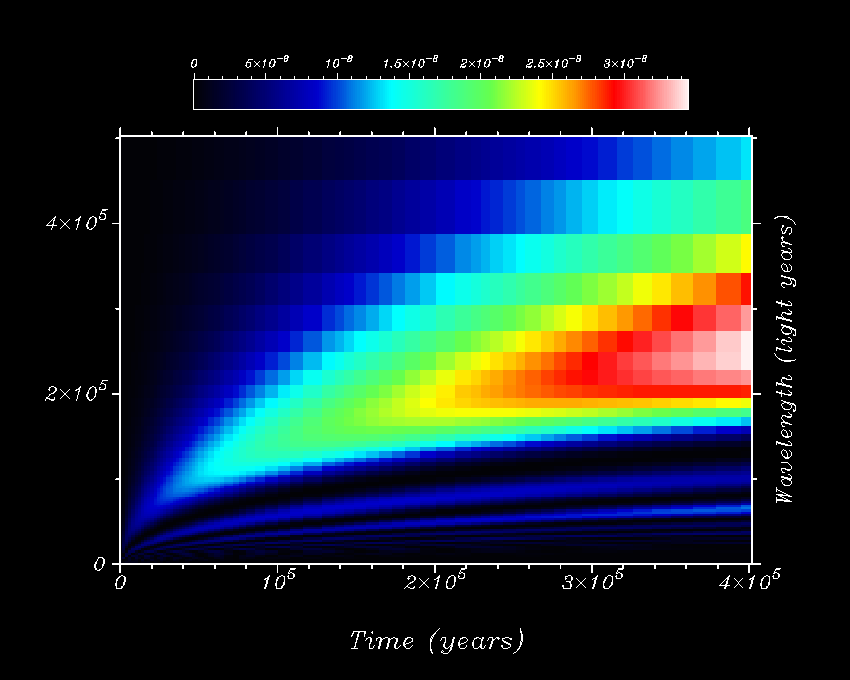
300,000 years
This is where things really get interesting.
So far, our entire discussion has been anchored in observations of the microwave background – and hence we've been focused on a single time, 400,000 years after the Big Bang. Because the sound waves appear frozen on the wall of fog, we only have an acoustic snapshot. Observationally, we cannot access earlier or later times — earlier is behind the foggy wall, and later is transparent and invisible. To track sound's evolution, we must rely on our trusty computer model: CMBFAST. This is the beauty of CMBFAST; not only can it clean up tiresome distortions, but it allows us to re-create the entire acoustic history of the Universe! If you are still dubious about using computer simulations, remember they are thoroughly vindicated at the time of the CMB, and for other times.... we have no other option!
Without too much trouble, I ran a series of models to generate this acoustic history, starting 100 years after the Big Bang, and ending 100 million years later. The next slide shows three examples from 300,000, 65,000 and 5000 yrs after the Big Bang. Try playing them now.

|
300,000 years |
Notice earlier times have much higher pitch – the harmonics look similar, but are simply located at higher frequencies. Also, the amplitudes are lower – the sound is quieter.
Obviously, one can splice the models together to get an fully evolving sound. Try playing the sound and movie now, and watch and listen to the evolution of the sound and sound spectrum across the first 400,000 years. The duration of the sound is, of course, arbitrary — I chose a brief 10 seconds to preserve a feeling of sudden expansion (that's about 40,000 years per second).
 |
Click image for more explanation
Run movie (1.4 Mb) |
Here are two other ways to show the sound's evolution across the first 400,000 years: with time on the x-axis; pitch on the y-axis; and loudness color coded — red for loud, blue/black for quiet. For the left diagram, the y-axis is frequency, so the harmonics drop down as time passes. For the right diagram, the y-axis is wavelength, so the harmonics move up as time passes.
Time (x) Frequency (y) Loudness (color)
 |
Time (x) Wavelength (y) Loudness (color)
 |
One way to describe the sound is a "descending scream building to a deep roar". A more mundane reference is to a jet plane passing close by, although in that case the drop in pitch is Doppler in origin, which is not what is occurring here.
So what is occurring?
The most obvious change is the drop in pitch. What causes this? The reason is that the regions into which the gas is falling and bouncing out are getting bigger. Think of of the sequence: picolo to recorder to clarinet to bassoon to tuba: the bigger the instrument, the deeper the pitch.
The reason the regions are getting bigger is not because cosmic expansion stretches them. This does in fact occur, but in this analysis the effect of cosmic expansion has been removed — all calculations are done in what are called "co-moving coordinates" which expand with the Universe, effectively freezing it out (click here for fuller explanation of co-moving coordinates).
The drop in pitch instead occurs because as time passes, the gas has had longer to fall into ever larger regions — so larger organ pipes are added to the register. Recall in topic 6 that the fundamental tone is set by how far sound can travel since the big bang (the "sound horizon") — this grows with time so the pitch drops. (Topic 13 gives a more detailed account of the role of horizons in primordial sound.)
The primordial sound also gets louder as time passes. This occurs because gravity is gathering more matter into the clumps, making the gravitational valleys deeper and deeper – so the gas falls in with more force, making a greater pressure, so louder sound.